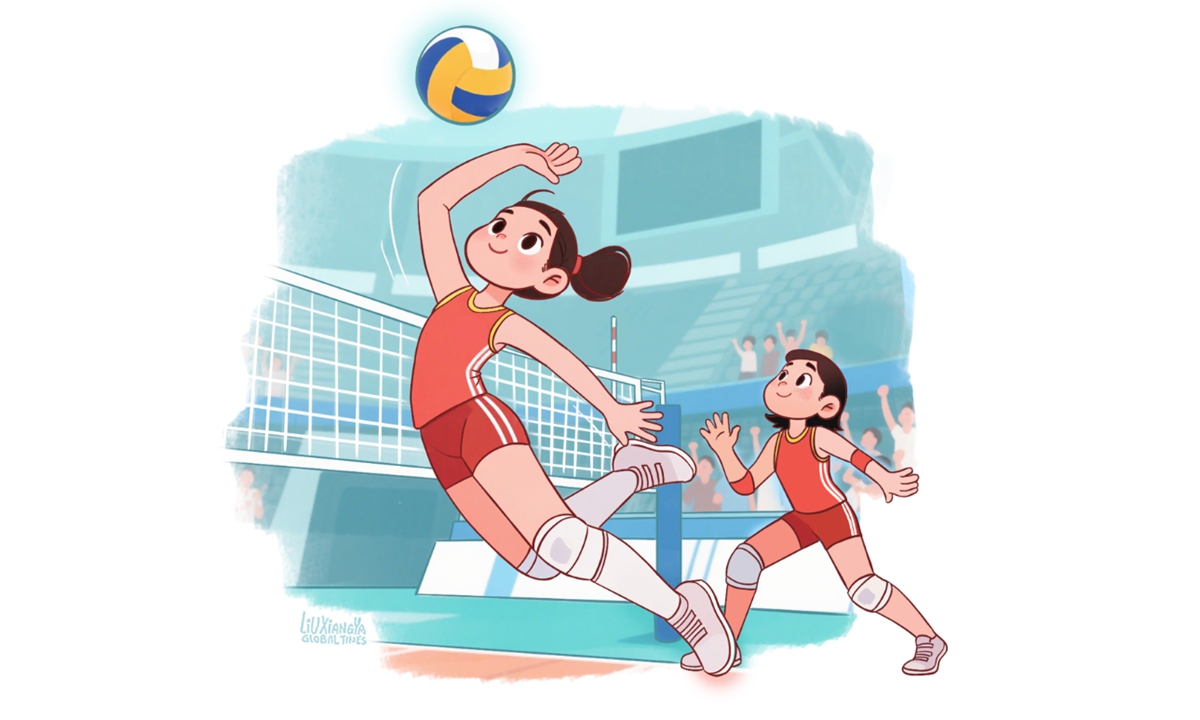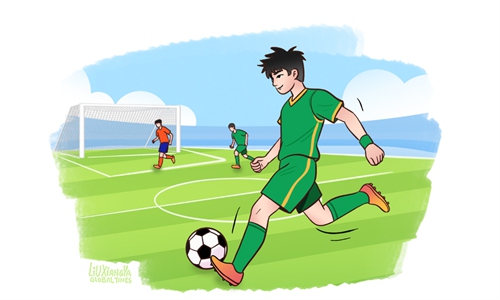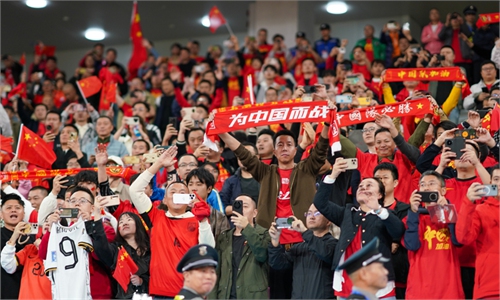ARTS / CULTURE & LEISURE
Promising beginning for resurgence of women’s volleyball

Illustration: Liu Xiangya/GT
The Chinese national women's volleyball team's curtain-raiser for the new Olympic cycle unfolded with two wins and two defeats on home soil during the Volleyball Nations League Beijing leg, which concluded on Sunday. With a fresh coach at the helm - Zhao Yong, a former youth coach promoted in April - this rebuilding phase has begun in earnest.Most of the 18-player roster is making their debut: Exciting newcomers include 17-year-old middle blocker Wang Aoqian, 21-year-old outside hitter Zhuang Yushan, 19-year-old Tang Xin, and others. Though veteran captain Gong Xiangyu, 28, leads, more than half the team is untested at this level.
These young players, however, burst into the spotlight through standout performances. Wang debuted against France, scoring 6 kills from 6 attempts - all converted points - for an almost flawless entrance. Zhuang tallied 25 points against Turkey and previously 15 points in the sweep over France. Main attacker Tang also delivered an efficient offense, while setter Zhang Zixuan deftly orchestrated first touches, providing the balance off this new spine.
This speaks to the classical Olympic-era Chinese culture of "elders guiding the new blood," Zhuang said, noting that the famed women's volleyball team's spirit continues to light the way: "As long as I'm on court, I will save every ball and refuse to let it fall."
This transitional model echoes China's youth pipeline success. The U17 women's team, led by Zhao since 2023, won gold in 2024, while in 2023, Zhuang was MVP of the U21 World Championship. These players have been groomed for international matches, and their VNL debut shows early rewards.
Over four intense matches in Beijing, China emerged with a 2-2 record: victories over Belgium and France, but losses to Poland and Turkey. Compared to the previous two Olympic cycles' slump, this is a step forward.
The France match illustrated this team's potential. Despite having several starters rotated out, China still swept decisively with 25-17, 25-18, 25-11, powered by Wu Mengjie and Zhuang, scoring 17 and 15 points, respectively; Wang Yuanyuan added 10 blocks.
Yet against Poland, a fourth-set lead of 21-19 collapsed under pressure, kicking off a six-point swing that forced a five-set decider. The narrative repeated in the Turkey rematch: Despite securing three match points in set four, China folded and ultimately lost 3-2 (15-12 in final set). Turkish star Alexia Carutasu logged 38 points alone - the type of elite performance China struggled to match.
What stands out is critical point fragility. Technical stats show China's unforced errors in key points soared to 37 percent, roughly 20 percent higher than opponents. China's offensive routines are undermined when the serve receive breaks down or miscommunication occurs in crunch time.
That said, the signs of growth are clear. Coach Zhao acknowledged both tension and momentum: "We saw progress… Inconsistency is part of the process for young players." Regular rotations are building depth; regular exposure builds tactical confidence. The young Chinese players may not yet be polished, but there is a clear upward trend.
Playing at the historically iconic National Indoor Stadium - the same dual Olympic venue from 2008 and 2022 - invoked echoes of past glory. The arena was packed and vocal, recording $1.5 million in revenue and over 16,000 spectators on peak days, organizers said.
Athletes and coaches agree that home energy boosts team morale significantly, offsetting young nerves at times. However, the flip side is that pressure intensifies expectations and can choke opportunities. In a way, the enthusiastic response from fans - even after losses - signals sustained support for China's women's volleyball brand, regardless of slumps or surges. History shows that the team had experienced similar pain after the 2000 Sydney and 2012 London Olympics, before regaining form.
If the Beijing leg outlined strengths and weaknesses, it also crystallized priorities for the next stop in Hong Kong, which is set to run from June 18 to 22.
The squandered match points highlight a need for composed court presence in apogee moments. Drills replicating high pressure serve ace scenarios could teach situational calm - identifying "break-point success" as a distinguishing skill of top teams. Younger players must continue learning rhythm, while core anchors like Gong, Wu, and Wang can shore up associations in tight sets.
Winning teams distinguish themselves by transition blocks and digs. China's middle-block line is capable, but needs consistent interaction with liberos and what's more important, tactical communication is essential.
China's women's national volleyball team is not just a sports unit but has become a symbol of grit and national pride. This group's ongoing resurgence - from frustration in Paris to rebuilding at home - mirrors a larger national journey from past complacency to future confidence.
The Beijing leg - 2 wins, 2 losses - is a trustworthy snapshot of China's volleyball at the moment. The scoreboard doesn't lie: New blood is breathing life into a traditional legacy. However, no championships are won on promise alone. They're built on mental fortitude, small point control, and seasoned composure.
The upcoming Hong Kong leg, with matchups against Japan and Italy, will be telling. Will the team adjust serve-receive under pressure? Can they finish crunch sets with ruthless efficiency? Continued home support will help, but team execution will matter more.
The author is a reporter with the Global Times. life@globaltimes.com.cn



